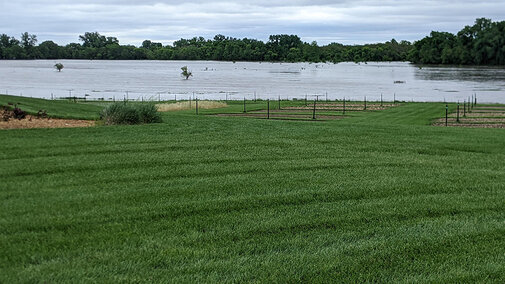A: Air temperatures, development stage of the plant, length of submersion, length of waterlogged/saturated soils, and pest pressure can all impact the outcome of flooded and saturated soils on wheat and alfalfa. Flowing water also contains more oxygen than stagnant water, which may help with increasing plant survivability.
Wheat:
Much of the wheat is currently in the headed to flowering stages. With heads present, the plants can become top-heavy and in saturated soils, may succumb to lodging, kinking or breakage of the stems. Stems that kink or break will not survive.
Wheat standing in saturated soil conditions, especially in low-lying areas, may succumb to premature plant death, potentially turning white.
Wheat submerged under standing water greater than 24 hours can result in concerns with pollination and subsequent kernel fill. Wheat waterlogged for 5-50 days beginning at flowering ranged from 4-90% yield loss (Olgun, Metin Kumlay, Cemal Adiguzel and Caglar, 2008, and Ghobadi and Ghobadi, 2010). Grain observations may include shriveled/shrunken kernels and lower test weights. While another study reported the potential for wheat yields to decline 2% per day that plants were waterlogged, it was also noted that tolerance to waterlogging vary amongst varieties.
Alfalfa:
Growth was reduced 56% and 33% when alfalfa was cut two and 12 days, respectively, prior to soil flooding. Crowns can be extremely susceptible to disease and there’s potential for alfalfa stands to not recover. In particular, alfalfa root and crown rot complex disease can expand if the alfalfa plants are water-logged for more than 3-4 days.
When waters recede, assess plants for brown, discolored roots and odors. Healthy alfalfa roots should be creamy white in appearance. In situations where patches or the majority of the field died, a warm-season annual (millets, sorghum sudan, sudangrass, etc.) could be seeded to compensate for the loss of forage production. Don’t attempt to reseed alfalfa into these areas due to autotoxicity issues.
Alfalfa can better withstand flooding damage if it was not cut prior to flooding occurring. Research showed the plants were not injured for up to 14 days post-flooding.
Allow soil to dry and firm before harvesting to avoid additional crown damage. Also, delay the next cutting to allow additional time for the alfalfa plant to recover.
References
Bauder, Sara. Sept. 12, 2019. Managing flooded alfalfa. https://extension.sdstate.edu/managing-flooded-alfalfa
Kaur, Gurpreet, Gurbir Singh, Peter P. Motavalli, Kelly A. Nelson, John M. Orlowski, Bobby R. Golden. December 2019. Impacts and management strategies for crop production in waterlogged or flooded soils: A review. https://doi.org/10.1002/agj2.20093
Lindsey, Alexander Lindsey, Mark Sulc, Laura Lindsey, Osler Ortez, Peter Thomison. June 15, 2022. Growth stage has major impact on crop survival in flooded conditions. https://ocj.com/2022/06/growth-stage-has-major-impact-on-crops-survival-in-flooded-conditions/
Lollato, Romulo, Erick DeWolf, Jeff Edwards, Health Sanders, Josh Bushong, and Mary Knapp. May 25, 2019. Can excessive rainfall prematurely kill the wheat crop in parts of Kansas and Oklahoma. https://eupdate.agronomy.ksu.edu/article_new/can-excessive-rainfall-prematurely-kill-the-wheat-crop-in-parts-of-kansas-and-oklahoma-337
Wiersma, Jochum. 2021. Wheat flooding and waterlogging. https://extension.umn.edu/growing-small-grains/wheat-flooding-and-waterlogging

